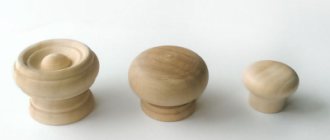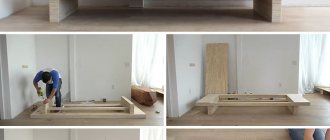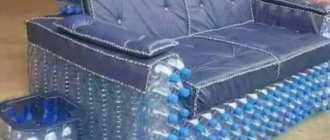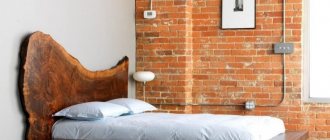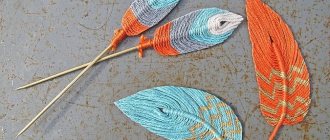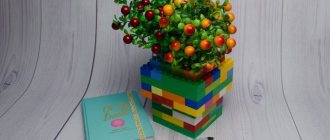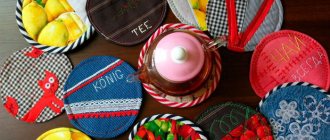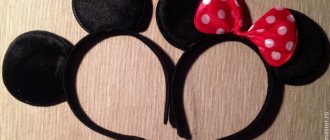by Alexey | Crafts Decor Workshop Furniture Cheap | Saturday, November 20, 2021
| Follow Make-Self.net on Facebook and be the first to read our articles. |
Stylish furniture that matches your interior is not only difficult to find, but also the high prices will greatly surprise you. Every middle-income person finds himself feeling his heartbeat with one hand and clutching his pocket with the other after hearing about the exorbitant prices of furniture in the market. If you can't find a way to avoid these harsh truths about inflation, then the only thing that can save you is your passion for making furniture yourself.
Here are collected the coolest ideas and projects for both creating furniture from scratch and restoring and remodeling old interior items. You will be inspired by extremely clever restorations, simple yet stylish designs to create unusual and charming furniture.
In this article we tried to include the most interesting furniture projects that you can make yourself. Over time, the number of projects will only increase. Take a look at 480 furniture examples to inspire you!
If your cat has been thinking about getting a personal cat house for a long time, then we recommend taking a look at 33 incredible cat houses.
Dinner table
When choosing a simple table, it will not be so easy to choose exactly the option and specific style that you would like to recreate. You can make your dreams come true even on a limited budget! We've rounded up 20 of the best dining table designs you can make yourself.
How to assemble a cabinet from chipboard with your own hands
Even a beginner can assemble a simple cabinet; to do this, you need to follow the following steps sequentially.
Table 5. Instructions for assembling the cabinet
| Illustration | Description |
| Step 1 | First, you need to make a sketch of the future product in order to have a clear idea of the size and number of parts, fasteners and accessories. |
| Step 2 | The cutting of parts is ordered from a specialized company or in a furniture shop, whose specialists must be provided with a clear list of parts with dimensions and designation of the sides to be edged. Where laminate edges will be made, subtract 2 mm. For example, if the length of the part in the drawing is 1085 mm, in fact it is necessary to cut out a part with a width of 1083 mm. |
| Step 3 | Important! When calculating the distance of the walls on both sides of the box, take into account 13.5 mm on each side per rail. |
| Step 4 | It is recommended to make the top cover of the cabinet 3-5 cm wider than the base. This will allow you to install it so that from below it does not rest against the baseboard or sockets on the wall. |
| Step 5 | After the guide location line has been drawn and the element has been attached, using an awl, a mark is made at the locations of the holes where the self-tapping screw will be screwed in. |
Step 6 | Guides for drawers are screwed to the side walls according to the markings. |
Step 7 | Markings for confirmations are applied to the side walls. |
Step 8 | The drilling point is marked using a sharp awl. |
Step 9 | The hole is drilled so that the screw head is subsequently hidden under a decorative rivet. |
| Step 10 | To fix the top cover, wooden dowels with a diameter of 8 mm are used, holes for which are drilled using a metal drill, onto which contrasting electrical tape is wound, indicating the drilling depth (12 mm) with a plate thickness of 16 mm. |
| Step 11 | The distance from the edge is 8 mm. |
Step 12 | The dowels are fixed with PVA glue. |
| Step 13 | To install the central partition, measure the length of the dowels installed in the lid array. |
| Step 14 | Drill holes for dowels to the required depth according to the markings. The drill must be kept strictly horizontal. |
| Step 15 | The dowels are lubricated with PVA glue and a partition is installed. |
| Step 16 | Connect the table top to the side walls. |
| Step 17 | A shelf is fixed to the confirmations. Using a clamp, fix the shelf and crossbar at a right angle. |
Step 18 | According to the markings, fix the shelf with a confirmation to the partition in the center. |
Step 19 | Using the method described above, another partition and shelf are installed. |
| Step 20 | The decorative edge should be located on the outside of the product. |
| Step 21 | At the next stage, partitions with guides and shelves are installed. |
| Step 22 | To protect the floor covering, felt pads with a self-adhesive backing are used. |
| Step 23 | When assembling the box, the distance from the edge under the confirmation is 8 mm. It is enough to retreat 30 mm from below and above. |
| Step 24 | The bottom of the LDVP box is fixed with furniture nails. |
| Step 25 | After the box is assembled, check its diagonals. |
| Step 26 | Guides are fixed to the ends of the box. |
Step 27 | A handle is screwed to the front of the drawer. |
| Step 28 | Drill holes for screws. Fix the facade. The screw heads are masked with decorative rivets to match the furniture. |
Simple sofa
Do you want to relax on the sofa after a hard day at work? But you are not satisfied with the size, color of the wood, quality of materials or price offered in stores. Take a look at 40 simple sofa designs to inspire you and save your family budget. If you want to make a sofa for relaxing in the garden, I suggest you take a look at 10 garden sofa designs.
Types of laminated chipboard structures
The use of laminated chipboard is widespread in various industries, one of which is furniture production. Laminated chipboard is used not only for the manufacture of simple furnishings, but also multifunctional furniture structures.
Kitchen set in modern style
Manufacturing of facades
The material from which the visible parts of the furniture are made, forming its decorative appearance - facades, must have an aesthetic appearance, match the style and color scheme of the interior, and also be moisture- and wear-resistant. If you need to make a drawer inside the cabinet, you can use a simpler material - 16 mm thick laminated chipboard with a 2 mm PVC edge. If this is the façade of a kitchen unit, then it must be made of beautiful and reliable material.
Minimalist facade of a kitchen unit made of laminated chipboard
The size of the standard facade is 2 mm smaller than the cabinet dimensions on each side. That is, if the cabinet is 60 cm wide, then the front will be 59.6 cm wide.
Dependence of furniture parameters and human anthropometric data
Kitchen furniture, first of all, should be ergonomic - convenient, comfortable and safe to use. Thus, floor and low wall cabinets have a height of 71.5 - 72.5 cm (it is worth taking into account the height from the floor to the top of the tabletop - at least 82 cm), and high wall cabinets - 91.5 - 92.5 cm. When manufacturing furniture according to an individual drawing, the anthropometric data of the apartment owner are taken into account when developing the latter.
Basic parameters of the kitchen set
Laminated chipboard facades differ from MDF in that it is not possible to create a relief pattern on their surface. However, this material is perfectly used to create sets in a modern style, the appearance of which requires minimal decor and conciseness. You can increase the decorativeness of the set by using fittings and inserts made of colored or embossed glass.
How to make a kitchen set yourself, what designs are the most convenient and reliable? More details in a special article.
Hidden elements – bottom and walls
To make the back wall of the box and its bottom, laminated fiberboards with a thickness of 3 to 5 mm are used. Their shade is selected to match the color of the chipboard used and fixed with the smooth side inward.
LDVP
Fastening LDVP is most often done using nails or self-tapping screws with a press washer. To prevent the plate from cracking, you must first make a hole for the screw and only then screw it in. When making drawers, a sheet of HDF can be fixed into a groove.
If it is necessary to increase the load-bearing capacity of the product, then the bottom is made of laminated chipboard.
Manufacturing of countertops
A horizontal work plane intended for preparing and eating food, performing activities related to reading books, writing, drawing, using a computer is called a tabletop.
Edge cutting
To design the working surface of the kitchen set, special laminated chipboards with a thickness of 28 to 38 mm, characterized by increased moisture resistance, are used. On their surface there is durable plastic, which is fixed using the “postforming” technology.
This technology consists of lining a chipboard slab with thin-thick laminated paper plastic under pressure and exposure to a temperature of 90 or 180 degrees. The difference is that in the first case, the slab is covered with plastic on the main side and at the ends, and silicone sealant is used to treat the joint of the coating.
Drip evacuation
In the second case (at a temperature of 180 degrees), the plastic completely covers the stove, going around the end of the tabletop, and sticks to it from the bottom, forming a drip tray. This is an important detail that protects the inside of the stove from moisture.
Note! For the manufacture of kitchen countertops, moisture-resistant chipboards are used - they are green when cut.
The most vulnerable point of a laminated chipboard kitchen countertop is the end cut, which must be hidden. In conditions of high humidity and intense operating load, a regular melamine edge will quickly cease to cope with its task. Therefore, aluminum end strips are used to protect the ends of kitchen worktops. There are also corner and connecting strips used to connect several modules that form a single tabletop - they cover the joints, protecting them from dirt and moisture.
Types of aluminum strips
Also, for protective and decorative purposes, a special plinth is used at the junction of the table top with the wall, when a decorative element of the required shade is attached to the guide.
From below, the tabletop is fixed to the floor cabinets using short self-tapping screws and horizontal spacers - this allows you to maintain the integrity of the smooth front surface.
Method of fixing the tabletop
Manufacturing of sliding doors
The sliding wardrobe is very popular - this method of opening the door allows you to save free space, which is important for small rooms. There are many models of sliding wardrobes: straight, five-walled, corner, trapezoidal, radius. Also, the main difference lies in the type of construction - stationary or built-in. In the first case, the cabinet is a box with two side walls and a back wall. In the second case, the side walls may be absent if the cabinet is built into a niche. If it is built into a corner, then you can dispense with one side wall. In this case, part of the load is distributed to the walls.
Basic elements of a wardrobe
The main element of such a cabinet is a sliding door, which, when opened, moves using rollers along guides. A sheet of laminated chipboard is inserted into a profiled frame; to achieve a decorative effect, it can be combined with other materials, separating them using an aluminum profile. The width of one door should not exceed 1 m.
Operating principle of roller guides
The guides along which the canvas moves are installed from below and from above. The upper guide is needed to fix the blade, and the lower one is needed for its smooth movement.
Plastic is used to make the lower rollers. The device is equipped with a shock-absorbing spring and an adjustment screw for adjusting the height. The upper rollers have a rubberized surface.
Accessories for sliding doors
In a special article, we will look at the advantages of sliding wardrobes, the main nuances of their installation, and give detailed instructions on how to independently assemble a spacious wardrobe for a small hallway.
Video - Stages of assembling a sliding door at home
Making a drawer
A drawer is a convenient storage element, which is present in cabinet furniture models made from chipboard for any purpose - in a kitchen set, in a desk and office cabinet, in a closet, at the bottom of a bed.
Chipboard chest of drawers with drawers on roller guides
The main element of the design is the guide, which ensures smooth opening of the drawer. There are two types of guides: roller and ball.
The roller guides are fixed to the bottom of the box. Movement occurs using rollers. The peculiarity is that the drawer will not extend completely. If it is heavy, then there is a risk of the drawer falling out when it is opened more than halfway.
The situation is different with ball guides, which allow you to safely pull out the drawer to its full length, while the structure moves smoothly and there is no risk of it falling out.
Ball guides
Table 2. How to assemble a simple roll-out box on roller guides
| Illustration | Description |
| Step 1 | One drawer will require two slides on each side. One will be attached to the side wall of the drawer, the second to the inner wall of the cabinet or cabinet. |
| Step 2 | When attaching the guide to the cabinet wall, 2 mm are removed from the edge. |
| Step 3 | Fix the guide with self-tapping screws so that their head does not protrude. |
Step 4 | The back wall and sides have an edge on one side and holes for Euroscrews on both sides. |
| Step 5 | There is a groove on the facade for attaching HDF. |
Step 6 | The drawer front is fixed to the side walls using an eccentric tie. Screw a “Twister” screw into the hole until it stops |
Step 7 | Wooden dowels are inserted into holes with a diameter of 7 mm, which can be lubricated with PVA glue for reliable fixation. |
Step 8 | The eccentric is inserted with an arrow into the outlet hole at the end. |
Step 9 | The part is installed and tightened clockwise. |
| Step 10 | The rear wall is secured using Euroscrews. |
| Step 11 | The HDF sheet is inserted into the groove on the reverse side of the facade and aligned. |
| Step 12 | Guides are screwed through the HDF. |
| Step 13 | The LDVP is fixed to the back wall with several self-tapping screws. |
| Step 14 | At the final stage, screw the handle. |
Bamboo furniture
Bamboo has great endurance in any conditions and retains its appearance for many years. Additionally, it is naturally stronger than other traditional hardwoods available and is very environmentally friendly. Check out 14 cool bamboo furniture ideas and ways to join trunks to get inspired to create a unique piece.
Features of the material
Laminated chipboard contains natural wood - in structure it is chipboards that have undergone high-quality sanding and covered with melamine film. It is this coating that distinguishes the two types of slabs. Laminated chipboard has high moisture resistance and greater strength than conventional boards.
The laminated surface exhibits greater resistance to mechanical influences, as well as to chemically active substances - acetone, gasoline, alcohol, acids, solvents, coffee. Therefore, furniture made from chipboard can often be found in public places: in reception areas, in offices, in multifunctional centers, in educational institutions, in cafes, in kindergartens, in playrooms and children's rooms, in the kitchen.
The advantage of the material is the variety of its shades and textures
The film not only gives the material excellent performance characteristics, but also allows you to give it a unique appearance - from any shades and textures of natural wood, to images applied according to individual sketches. The ability to choose any shade allows you to produce cabinet furniture for any interior. This is especially true for children's rooms, where bright, rich colors are welcome. Bright furniture is also used for advertising and trade stands, as a body for reception desks with the possibility of being manufactured in the company’s colors with a logo.
Multifunctional cabinet furniture
Note! The laminated layer makes the surface of the chipboard monolithic and does not allow harmful substances that may be contained inside its structure to pass through.
The formation of the laminated layer occurs by pressing paper, which acquires properties comparable to plastic, filled with melamine resin under pressure (up to 28 MPa) and high temperature (up to 210 degrees). Decorative paper impregnated with resin is pressed into the top layer of chipboard.
The surface of such a plate, among other things, is heat-resistant, which allows you to place hot dishes on it - this has made laminated chipboard a popular material for making kitchen countertops.
Cutting laminated chipboard
Shelves and racks
The day has come when your books will no longer be on a chaotic journey around the apartment. It's time to make shelving, and our selection of 40 unique shelving and bookshelves that will awaken the urge to make your own will help you with this.
Here are hanging shelves that are perfect for small spaces.
Scheme and drawings
In order to independently assemble any furniture structure, the craftsman needs a drawing on which the technological process of installing the assembly unit is “outlined” in detail and clearly. The presence of schematic images simplifies the task. It is worth noting that the manufacturer is not responsible if customers damage wood chips, mirrors, or plastic parts during the assembly process, so the work must be done carefully, use mechanical equipment, and carefully study the attached diagram and instructions. What useful information does the drawing contain:
- instructions for assembling the unit (kit). Typically, the manufacturer indicates that the order’s complete set of parts, fastening, connecting, mounting, and decorative fittings must be checked upon receipt of the goods;
- the assembly of Italian furniture or a regular set from a furniture supermarket begins in the same way - with studying the specification, which indicates the number of parts, their name, size, code;
- a separate table shows the specification of fittings, consumables, and fasteners. For ease of use of the drawing and assembly diagram, the name and size of the fittings are given - screw, bolt, clamp, confirmat, clamp;
- The craftsman needs text instructions to correctly assemble the product - the specification and assembly order are indicated for each unit, and the design details and fittings are marked on the drawing - a template for drilling holes.
The diagram on how to hang a mirror deserves special attention. There are several options for installing mirror panels. To choose the appropriate installation method, you need to consider the weight of the mirror and the strength of the base plate. Technology for hanging a mirror:
- use double-sided tape - place glued strips of tape on the surface of an MDF or chipboard, “try on” the mirror, remove the protective film and fix the glass. The work is carried out with the part in a horizontal position so that the glue on the mounting tape sets. You can hang the mirror vertically, increasing the consumption of adhesive tape;
- acrylic glue - necessary to hang the mirror without damaging the amalgam. The sealant can be applied dotted or in separate strips, distributing the adhesive over the surface indented from the edge of the mirror. It is recommended to glue the slab to the mirror part in a horizontal position. Equipment for work – glue gun, glue dries in 24 hours;
- colorless construction silicone is quite suitable for securely hanging a mirror on a cabinet door. To firmly glue the parts, it is not necessary to apply silicone to the entire back surface of the mirror; it is enough to distribute the substance in thin transverse stripes, attach the mirror glass, and fix the decorative frame to the glued mirror.
As an alternative, you can use fastening hardware made according to the principle of clamping tabs. But the disadvantage of this method is the presence of visible parts of the mounting hardware. To avoid drilling mirrors and glass parts, accessories such as clamps are widely used. There is a large selection of products in terms of construction, design, and material of manufacture - the gluer can be made of plastic, have a transparent structure, round or rectangular shape. A clamp is a universal device that acts as a mirror holder or glass shelf holder. Installation option - fixation with a self-tapping screw or drilling under the clamp.
An example of a diagram for assembling a children's wardrobe according to the manufacturer's drawing: place the right side on a table for assembling furniture, install the rod holder, guides, hinge counters, rods. Place the bottom on the dowels, secure the left side panel using eccentric fasteners. Insert the back wall into the groove, secure the connecting beam, and secure the left side panel. Next, the box is assembled according to the diagram - the rods are screwed in, the sides of the box are mounted, the unit is secured with eccentrics, and the bottom is secured with euroscrews - confirmats.
After hammering in the thrust bearings, the children's closet is placed in a vertical position on the furniture assembly table, and the door hinges are mounted on self-tapping screws (the size is indicated in the drawing). The final stage of assembly is the installation of doors, rods, handles, then a drawer and shelves are inserted into the cabinet. Using such a simple and understandable diagram, which is attached in the drawing to the furniture structure, you can assemble any cabinet unit - a table, a chair, a wardrobe, a bed.
Plywood furniture
In the era of minimalism, natural motifs and naturalness, plywood could not have come at a better time. More recently, this material was considered faceless, unsightly and too cheap in appearance. Today, along with exposed brick walls and bare concrete floors, plywood furniture is in fashion. It's worth taking a look at 50 examples of plywood furniture. You might also be interested in this article about a list of projects that can be made from just one sheet of plywood.
Pros and cons of using laminated chipboard for making furniture
The advantages of laminated chipboard include the following:
- Low cost.
- Easy processing.
- Ability to cut parts of any shape.
- The presence of a safe edge at the ends.
- The ability to create furniture with rounded corners, which is especially important for children's furniture.
- Excellent performance properties: mechanical, thermal, chemical resistance, moisture resistance.
- Preservation of operational properties throughout the entire life of the furniture.
- Wide range of colors.
- Easy care, possibility of daily wet treatment.
The laminating layer protects the boards from the negative effects of moisture, which makes it possible to make furniture from them for rooms with high humidity.
Kitchen set made of laminated chipboard
The disadvantages of laminated chipboards include the fact that they contain formaldehyde, however, the laminating layer and the sealed edge at the ends of the furniture completely neutralize the release of harmful substances into the environment. The edge also protects the slabs from moisture, which can cause them to swell.
Edge
As noted earlier, any part made of laminated chipboard must have an edge that will protect the material from moisture and the environment from the harmful effects of formaldehyde. Having a drawing of the product in hand, you can order sawing and edging from a specialized company that has special equipment. In the future, you can assemble the finished product yourself.
Melamine edge
Table 1. Types of edges
| Edge type | Description |
Melamine | The budget option is not of very good quality. Using an iron, you can glue it yourself. |
| PVC | This edge is fixed using special equipment during the cutting of individual parts. It is made with a thickness of 0.4 mm and 2. A thin edge is made on the invisible ends, and a thicker one on the outside, where more serious impacts are possible. |
T-shaped mortise | A rare type of edge in use, which has a T-shaped section and is fixed into a groove at the cut. |
| U-shaped waybill | A significant disadvantage is that the edges protruding a few millimeters are vulnerable to contamination. The advantage will be the ability to hide a poorly executed cut. |
Original furniture designs
Below are interesting furniture designs, some of which cannot be brought to life without drawings and specialized tools. But friends, try, create and you will succeed! Don't spend a lot of money on designer tables. They were also made by people. Why can't you?
Preparatory process
The creation of any furniture always begins with the design of the future item. This can be done in the traditional way, drawing a drawing on paper, or using special programs. You should also make accurate calculations and select the necessary parts for the product.
Types of furniture staplers, their features and scope of application
Design
Today there are many 3D programs for creating furniture designs. Their main advantage is that there is no need for design skills. There is no need to study information on sizing calculations and draw on paper - not every person has such skills. Of all the programs, there are 5 most popular:
- Volume;
- T-FLEX Furniture;
- SketchUp;
- Adobe Photoshop;
- DYNALOG.
Before printing a drawing for the manufacture of cabinet furniture, you should double-check everything carefully. Otherwise, one mistake in calculations can reduce the efforts to nothing - nothing will be remade.
The nuances of assembling cabinet furniture, useful tips for beginners
Volume T-FLEX Furniture
SketchUp Adobe Photoshop DYNALOG
Assembly drawings
It is advisable to create an assembly drawing that will simplify the manufacture of furniture. It includes:
- images of all parts, providing information about their connection and location relative to other parts of the product;
- exact dimensions;
- designations of permanent connections and conventional numbers of components;
- specifications.
An assembly drawing is a type of engineering document that shows the location of all parts of a product and their relationship to each other.
Calculation and detailing
The technology for manufacturing cabinet furniture requires careful adherence to preliminary calculations. The design of the product must maintain rigidity. This can be achieved using a back wall or drawer, which is fixed at an angle of 90 degrees between the panels. Without these parts, the furniture will constantly wobble or fail.
It is important to remember about gravity - all unsupported elements with a length of more than 90 cm will sag. The thickness and width of the part will not affect this in any way. It is also necessary to calculate partitions that will not prevent the product from serving its intended purpose and will serve as a rigid frame.
How to use wood putty
It happens that chips, dents or deep scratches appear in the wood due to mechanical stress. In this case, you will need wood putty to disguise these imperfections. If you've never worked with this material before, be warned, it may soon become your favorite item in the toolbox. Find out in more detail how to use putty on wood, it will definitely come in handy.
Follow us on Pinterest for more interesting articles.
Useful short videos from Make-Self.net
Manufacturing
To successfully make cabinet furniture with your own hands, you must carefully follow all the steps:
- preparation of parts;
- processing of sections;
- marking of fittings;
- installation.
Having completed the calculations and begun assembling the product, in no case should you work without a drawing or act at your own discretion. If a new idea arises, you should create another diagram that will take into account all the amendments.
Preparing parts
When working from scratch, you first need to cut out the furniture parts - thick paper or cardboard will do. Next, you will need a high-performance machine with a high cutting frequency. Having placed the workpieces on it, you need to cut the material, saving space if possible. This will help reduce wood costs.
Ready-made options can be found in furniture departments and on the market. In this case, no machines will be required. If the raw materials are not processed, then the parts must first be covered with self-adhesive film or special plastic.
Cut parts Cut
Processing slices
Before you start assembling the parts, you need to glue the sections. For this you will need edge tape. Before work, you need to make sure that the humidity in the room is low - it is advisable to dry and warm the workshop well. You will also need equipment; a regular iron and a construction knife will do. Sometimes the edge is initially equipped with a sticky layer, then there is no need to further treat the surface.
How to make your own furniture from plastic bottles, instructions
During gluing, the iron should be kept at a short distance from the cut to prevent possible displacements and to secure all parts well. If you overexpose it, the edge may overheat and burst. When it is fixed, use a knife to trim the edge and smooth out all the irregularities.
Tape over the cuts Trim the edge Clean up any uneven areas
Marking of fittings
Correct technology involves placing the finished parts of future furniture on a flat surface for marking. Following the plan, you need to mark all the places where the fittings will be attached. It is advisable to double-check the dimensions, since an error of 1 cm can distort the entire structure. Next, you need to make holes in the marked places and screw in the fittings.
Mark and drill holes
Screw in the fittings
Installation
In accordance with the plan, the cut parts must be connected. For screeding, it is important to prepare a screwdriver with special attachments. This way the twisting will happen much faster than with a screwdriver. Nails should not be used to strengthen the bottom. The best choice would be self-tapping screws measuring 4 by 16. All edges must be fastened at an angle of 90 degrees using corners. You can nail the back wall to the assembled frame.
In order for the sliding mechanisms to operate smoothly, the guides must be properly fixed. They should be attached parallel to the horizontal edges of the product. Then attach special rollers to the doors, the movement of which checks the operation of the entire mechanism. After installing the sliding system, the furniture begins to shrink, which can cause gaps to appear. This is considered normal and depends on the characteristics of the material.
All that remains is to attach the fittings. All shelves, hooks and drawers must be installed in their places. The product is ready for use. Even an inexperienced person can handle the design of cabinet furniture.
Making cabinet furniture allows you to acquire useful skills that in the future will help you create entire sets for various rooms. All products in the house will have a unique design that will surprise and delight guests. For example, assembling a cabinet takes no more than 3 hours for novice craftsmen.
Conclusion
Making a cabinet with your own hands or buying it in a store is everyone’s choice, but a cabinet made by yourself has more advantages than a store-bought one.
Such a cabinet will definitely look good, because its dimensions are ideal for the space in which it is located.
Anyone can make a closet, even without anyone’s help, so you don’t have to be afraid that nothing will work out.
Furniture fasteners
Furniture fasteners are hardware (metal products) that are used to connect parts. Most often, connections are made at right angles.
- Wooden dowels - inserted into pre-drilled holes in both parts. They are used for preliminary fixation and increasing the shear load, then the parts are fixed in a more reliable way.
Dowels
- Furniture corners are a popular, but outdated type of furniture fastening. Among the disadvantages: appearance, loosening over time and bulkiness.
Furniture corner
- Euroscrew (confirmed) – furniture screw. This is the main fastener for parts in modern furniture. Furniture makers almost never use ordinary self-tapping screws. Confirmats have a larger thread, so they stay inside the chipboard much better.
Confirmat
The holes for them can be drilled directly on site. To do this, use a special drill that makes a hole with different diameters for the thread, neck and head of the Euroscrew. The most commonly used confirmats are 7*50 mm. When drilling, special attention should be paid to the perpendicularity of the drilling, so as not to spoil the coating of the part with a through hole.
Drill for euroscrew
Furniture screws are tightened with a hex key or a screwdriver attachment. The caps for a Phillips screwdriver cannot be tightened tightly until the end.
The main disadvantage of this type of fastening is that screwed-in caps remain visible. To hide them, use plastic plugs matching the color of the chipboard.
- Eccentric ties are a modern and correct method of fastening. It leaves a hole only on the inside of the product, but requires very precise drilling.
Eccentric couplerTo obtain the required holes, use a Forstner drill. There's not much point in going to the trouble of using them to assemble items that will be hidden, but they work well for attaching drawer doors.
Forstner drill
Article on the topic: DIY kitchen assembly.
How to decorate a closet?
If your cabinet is made of natural wood, first you need to cover it with a special solution that will prevent the wood from becoming rotten over time. After this, the cabinet can be left in its natural color, or it can be painted using a special wood paint.
If a plain cabinet seems too uninteresting to you, you can arm yourself with a simple pencil, brushes and acrylic paints, draw sketches with a simple pencil and outline it all with acrylic paint.
The patterns with which a closet can be decorated can be very different, from circles and stripes to complex ornate patterns.
After any painting, the cabinet must be varnished so that its appearance remains attractive for a long time.
Drawers and slides
There are many ways to make furniture boxes. The simplest of them is to assemble a perimeter from laminated chipboard. If a beautiful facade is required, it is screwed onto the main frame from the inside (like the tabletop). The façade can also be secured to eccentrics as the fourth wall of the drawer.
But the main thing is not to assemble the drawer, but to secure it correctly.
Drawer guides are divided into roller or ball guides.
- Roller guides are usually attached to the bottom of the drawer. He will ride on them on two rollers. A pair of such guides costs about 150 rubles, but it is highly not recommended to use them. The main disadvantage is that they do not allow the drawer to be pulled out completely; a heavy drawer in the more than half-open position may simply fall.
- Ball guides, or as they are also called, “full extension telescopic guides,” can exactly double the length. They have many balls inside, like bearings, so they provide a smooth ride.
Roller and ball guides for drawers
- In addition, Blum has metaboxes and tandemboxes. These are ready-made side walls of drawers with installed guides. All that remains is to install the façade, back wall and bottom.
Examples of stylish design of garden furniture
The dimensions of garden furniture are not so important, but in order for the items not only to perform their functions efficiently and for a long time, but also to be a decoration of the garden, they are often decorated with additional elements. One of the most striking examples for decoration is fresh flowers, and wildflowers will look especially bright.
Another method to make garden furniture a real piece of art is to decorate it with a beautiful accessory, for example, pillows or a blanket. Decorating garden tables with plastic or glass tops looks no less beautiful.
By studying and carefully applying the recommendations from this article on creating country furniture from wood with your own hands, diagrams and assembly drawings should not be thrown away; they can come in handy in the future. If you also use the decorating techniques with additional accessories that are described in the text, the furniture can become a wonderful place to relax. With such pieces of furniture, spending time will be comfortable and enjoyable.
